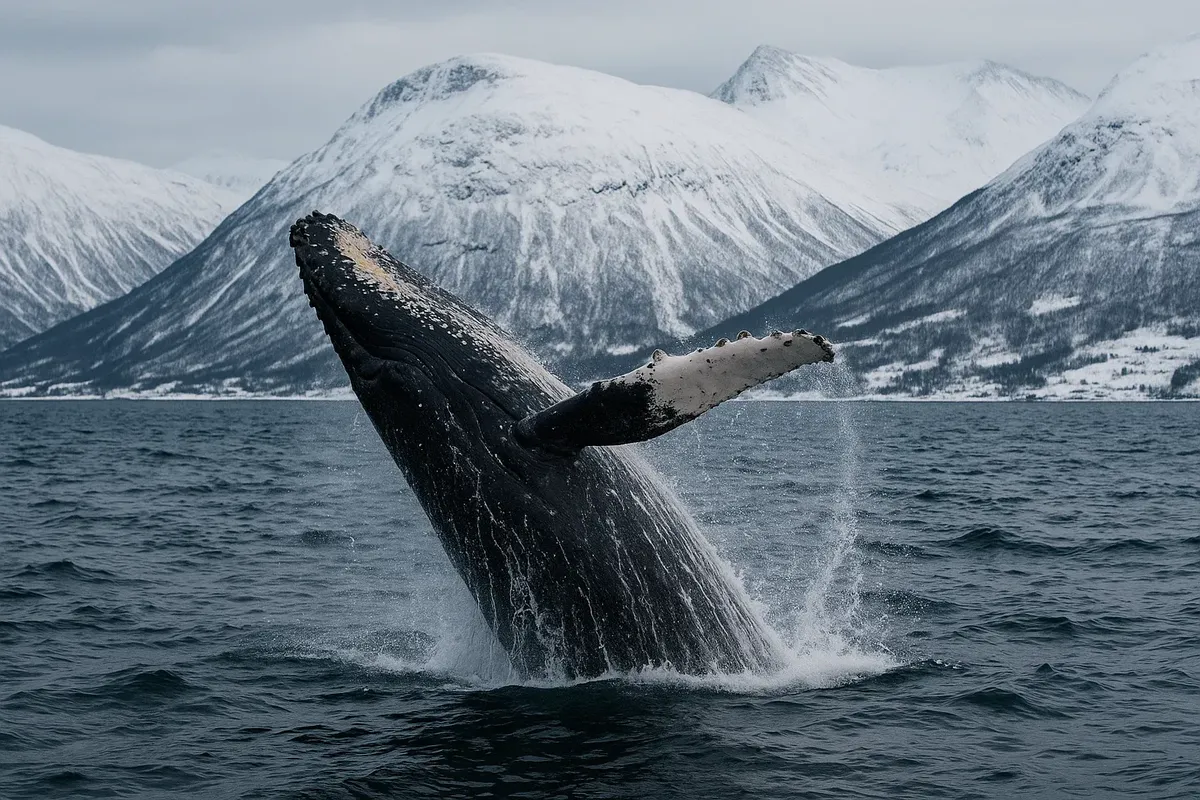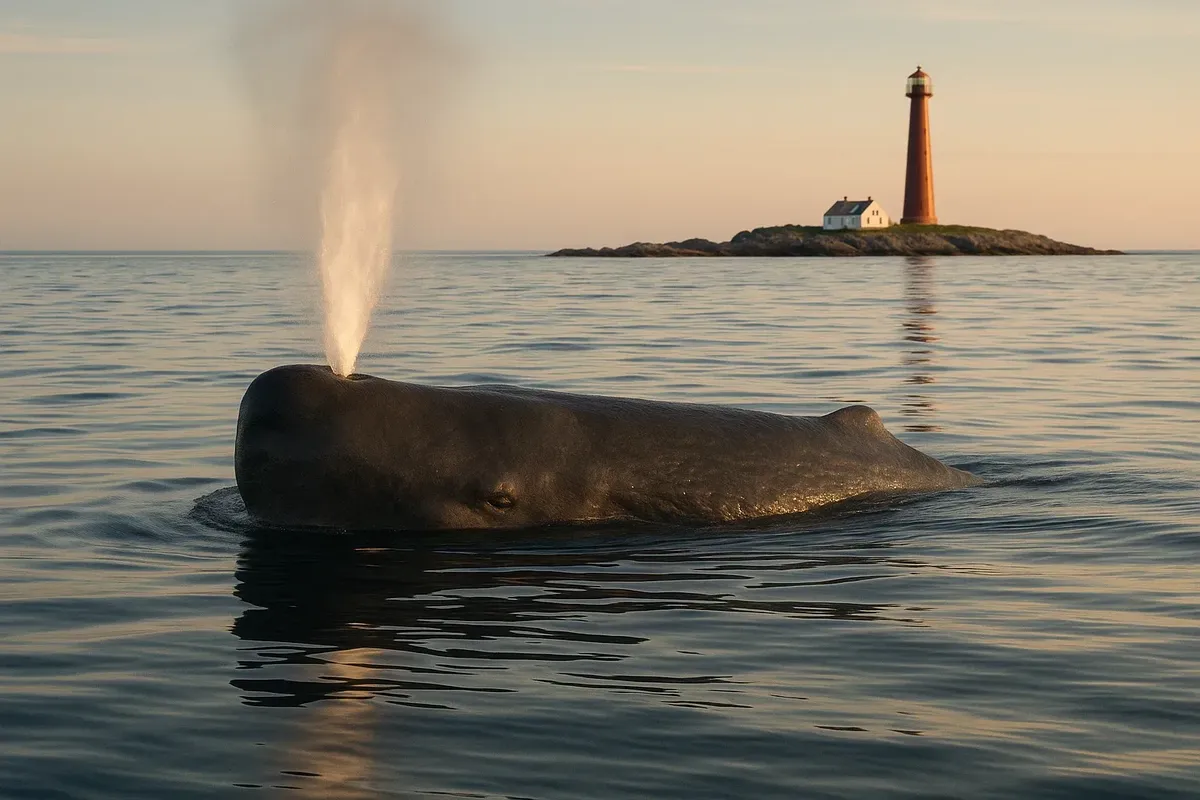🌊 Whale watching in Norway: a guide to the best places and times of year
Norway is one of the best places in the world to see whales in their natural habitat. Thousands of tourists come here to observe these majestic giants of the ocean. Whales amaze with their size, grace and mysterious behaviour, making every encounter with them unforgettable.
📝 Here's what you'll get out of this article:
- Do you know what types of whales can be found in Norwegian waters?
- If you're looking for the best spots for whale watching, you've come to the right place!
- The best time of year to see those amazing whales!
- Totally get it – how on earth do you choose the right tour?
- We've got some great tips on equipment and safety for you!
🐋 Norway is a great place to see all kinds of whales!
Humpback whales!
Humpback whales are the stars of the sea, adored by all who come to see them. These beautiful creatures are well-known for their 'jumps' and playful behaviour. Humpback whales are such friendly creatures! They have a distinctive fin and huge flippers, and they love to show them off when they jump out of the water.
- Size: 13–17 metres, weighing up to 40 tonnes.
- Best locations: Tromsø, Vesterålen, Lofoten.
- Sighting season: November–February.

My dear friend, today I will tell you all about the amazing sperm whales!
Our friends the cascalots are real experts when it comes to exploring deep water areas and diving down to really impressive depths to find what they're looking for. It's so lovely to see them come out and play on the surface, isn't it? They really enjoy it! We know how much our tourists love to watch the world go by in all its calm and peaceful glory.
- The size is: It can be no more than 20 metres long and weigh no more than 50 tonnes.
- The best places are: West Sterol, Inc.
- The season is now over. May to September.

Let's talk about fin whales!
The fin whale is a really special creature – it's the second largest whale on the planet after the blue whale! These gentle giants love to chill in the open sea. You can often spot them by their high water spouts and smooth movements.
- Size: up to 27 metres, weight up to 70 tonnes.
- Best locations: Waters near the Lofoten Islands, west coast.
- Sighting season: June–September.
🌟 The best regions for whale watching in Norway 🇳🇴
1. Welcome to the beautiful city of Tromsø!
Tromsø is a wonderful place to see whales. It's the best place in Norway to do that! From November to February, we are delighted to tell you that large pods of humpback and killer whales come here. It's all down to the huge schools of herring that these giants love to swim around. We're so excited to tell you that our tours are conducted every day on specialised vessels!
2. Welcome to the beautiful Vesterålen archipelago!
Andenes in the Vesterålen archipelago is the perfect place to watch sperm whales. Our local guides are like the superheroes of the animal kingdom! They know these creatures like the back of their hand and will make sure you get up close and personal. If you're planning a trip, I would really recommend visiting during the months of May to September. This is the best time of year!
3. The beautiful Lofoten Islands
When the autumn and winter months arrive, the Lofoten islands become a magical place to visit. If you come at the right time, you can see amazing whales and killer whales in their natural habitat. The beautiful landscapes make the trip especially memorable.
4. Bergen and the west coast – what a lovely combination!
The area around Bergen is just perfect for spotting fin whales. During the summer months, our lovely tourists also have the opportunity to see minke whales and dolphins.
📅 When's the best time to see those beautiful whales?
The winter season is from October to February.
- If you're looking for a chance to see humpback whales and killer whales in their natural habitat, now is the perfect time! If you're lucky, you might even spot a whale or two during your trip!
- The summer months (May to September) are the best time to go and see sperm whales, fin whales and minke whales. The water is lovely and calm, and the weather is much more pleasant for sea excursions.
I totally get it – how do you choose the right tour?
When choosing a tour, here are a few things to keep in mind:
- Type of boat: If you're anything like me, you'll love the idea of choosing vessels with special platforms and observation decks for sightseeing!
- Group size: If you're not sure, the smaller the group, the better the viewing experience will be.
- How long does it take? You'll be pleased to know that our tours usually last between two and five hours.
- Company reputation: Hey, when you're planning your trip, it's always a good idea to read reviews. That way, you can find out about reputable operators with licences and experienced guides.
Just a friendly reminder of what you might want to bring with you on the tour!
We know how important equipment is when you're out on a tour, so we've made sure to include everything you need for a comfortable and safe trip. And don't forget to bring:
- It's so important to wrap up warm and stay cosy in waterproof clothing!
- And don't worry about slipping – these shoes are non-slip!
- Hat and gloves, too.
- Don't forget your sunglasses and sunscreen (even in winter, the sun can be bright).
- All you need is a pair of binoculars and a camera with a powerful lens!
- Don't worry, I've got you covered with a little snack and some water!
We've got some great tips for you to make sure your whale-watching trip is a really special experience!
- And don't forget to book your tour in advance, especially during peak season.
- Hey, just a heads-up: if you're planning a trip to see the whales, it's always a good idea to check the weather forecast first. Storms can make it tricky to spot the whales, so it's better to be prepared!
- Please be patient — it might take a little while to spot a whale!
- Please, dear friend, listen carefully to the guide and follow their instructions.
- Please don't feed the animals or try to attract their attention with loud noises.
Just a friendly reminder of the safety rules when you're out there meeting those amazing whales!
Whales are not aggressive creatures, but it's always best to be prepared.
- And please, never jump into the water near whales.
- Please remember to keep your distance and show respect for their personal space.
- If you're lucky enough to spot a whale from a private boat, it's always best to stay calm and keep your cool. Observe the speed limit and move parallel to the whale's route, not directly towards them.
- Please, if you could make sure you follow the instructions of our helpful guides and friendly crew, that would be absolutely wonderful!
We're all in this together when it comes to environmental responsibility!
We all have to take responsibility for tourism. Here are a few things to keep in mind:
- And please, whatever you do, don't throw rubbish into the water.
- Please be sure to keep the animals undisturbed by noise or light.
- When you're choosing companies, it's really important to go for ones that comply with environmental standards and support the protection of marine animals.
Whale watching in Norway is such an amazing experience! It's a chance to see these beautiful creatures in their natural habitat and it's something you'll never forget. If you put a bit of thought into where and when you go, and get ready early, you're sure to have an amazing time!
And don't forget to take some beautiful photos to remind you of this exciting journey to the sea giants of Norway.





2 comments
Log in to leave a comment
Hvor i Norge mener dere man har størst sjanse til å se hval, og hvilken sesong er best? 🌊